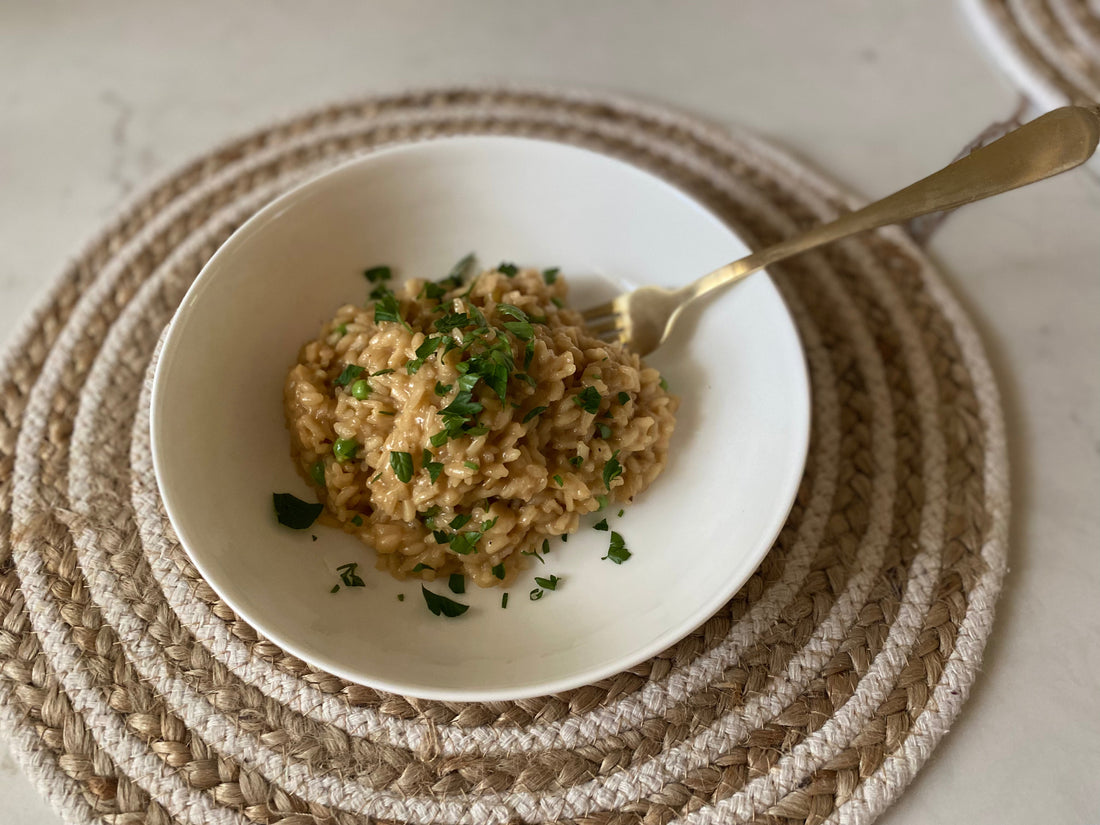
Garden Pea Risotto with Egyptian Walking Onions
Prep Time: 10 minutes
Total Time: 35-40 minutes
Servings: 2–3
Why This Recipe Exists (And Why I Love It)
This was the year of the peas—though I didn’t know it at first.
The spring was all over the place. One minute it felt like late March, the next it was full-on summer. I honestly wasn’t sure the peas would make it. But with a little patience (and a lot of weather watching), the vines pulled through—tossing out delicate blossoms and eventually, handfuls of petite green pearls.
These sweet little garden gems deserved a spotlight, not a side role. And risotto felt like the right kind of canvas: cozy, creamy, and the perfect partner to something so fresh and seasonal. Egyptian walking onions—those funky, fabulous perennial alliums—were just the bonus characters. Subtle, savory, and just oniony enough to round out the dish.
Risotto can be a bit of a diva in the kitchen—requiring your full attention and a steady stirring arm—but the result is rich, bright, and satisfying in the most spring-forward way.
Why You’ll Love This Recipe
- A beautiful way to use fresh garden peas
- Highlights unique garden ingredients like Egyptian walking onions
- Rich and comforting, but still light enough for spring
- An excellent entry-level risotto recipe for home cooks
Ingredients
From the Palate Patch Garden
Petite Shelling Peas

For the Main Dish:
- ¼–½ cup petite shelling peas (freshly shelled)
- 1 spring Egyptian walking onion (use bulb and white part only)
- 1 sprig of fresh parsley (torn)
- 2 tbsp olive oil
- 2 garlic cloves, thinly sliced
- ½ cup arborio rice
- ¼ cup dry white wine (like Pinot Gris)
- 3 cups chicken stock, heated and kept warm
- ¼ cup grated parmesan cheese
- 1 wedge of lemon
- Salt and pepper, to taste

Instructions
Step 1: Start the Base
- In a Dutch oven or heavy-bottomed pan, heat the olive oil over medium heat. Add your sliced Egyptian walking onion and cook until translucent, about 2–3 minutes.
- Add the garlic and cook for 30 seconds more, stirring constantly to keep it from browning.
Step 2: Toast the Rice
- Add the arborio rice to the pan and stir well, letting the rice toast and get slightly golden, about 2 minutes.
- Pour in the white wine to deglaze the pan, stirring as it bubbles and soaks into the rice.

Step 3: Build the Risotto
- Begin adding the warm chicken stock, ½ cup at a time, stirring continuously. Wait until the liquid is mostly absorbed before adding the next ladleful.
- Repeat this process until all the stock has been incorporated and the rice is tender but still has a little bite—this will take about 20 minutes. You want it creamy, not gummy.
Step 4: Finish and Serve
- Remove the pot from heat. Stir in the parmesan cheese and your shelled peas (they’ll cook quickly in the residual heat).
- Finish with a generous squeeze of fresh lemon juice and a crack of black pepper. Taste and adjust salt as needed.
- Serve warm, topped with a few extra peas and fresh torn parsley.
Notes & Tips
- Easy on the salt: Due to the saltiness already from the chicken stock and parmesan, make sure to start off with just a small amount of salt. You can always add more later if needed.
- Make it vegetarian: Swap chicken stock for mushroom or vegetable broth.
- No walking onions? A regular spring onion or shallot will work just fine.
- Don’t rush it: Stirring consistently is key to that creamy, dreamy risotto texture.
- Use what you’ve got: Frozen peas can be a great stand-in if you’re out of fresh. You can even sub in spinach or asparagus as other vibrant spring veggies to highlight.
Serving Suggestions
- Serve with a crisp glass of the same white wine you cooked with
- Top with a soft-poached egg for a more filling dinner
Storage & Reheating
- Store leftovers in an airtight container for up to 2 days.
- Reheat gently on the stove with a splash of broth or water to loosen the texture. The microwave works as well if you must.
- Not freezer-friendly—risotto texture tends to get grainy when thawed.
FAQs
Can I make this dairy-free?
Yep! Just skip the parmesan cheese.
What other grains can I use instead of arborio rice?
While risotto is traditionally made with arborio rice, you can experiment with pearl barley or pearl couscous--just note the cook time and texture will differ.
Your Turn!
Tried this recipe with your own garden peas? Tag us @PalatePatchCSA on Instagram or drop a comment below. Whether you’re stirring this up on a weeknight or celebrating the first spring harvest, I hope it brings joy to your palate!
